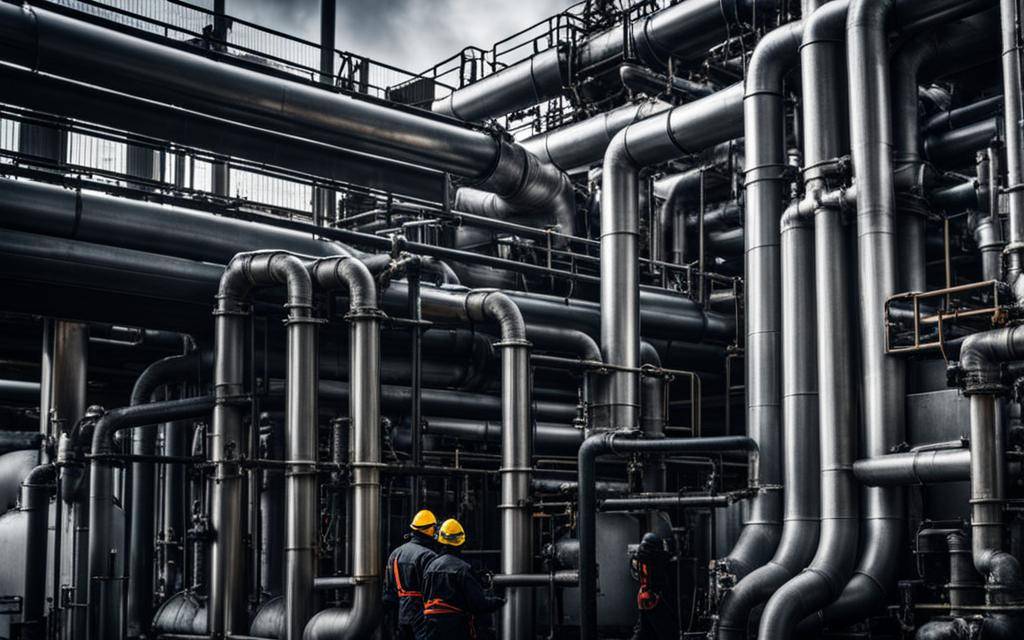When it comes to working with hazardous materials, understanding the risks and staying safe is paramount. In industrial settings, there are various toxic gases that pose serious health risks. It’s crucial to be aware of these dangerous substances and take necessary precautions to protect yourself and your colleagues.
One way to assess the toxicity of gases is through the LC50 measure, which determines the concentration that is lethal to 50% of the test subjects. In the United States, toxic gases are assigned NFPA 704 health ratings of 4 or 3, indicating their potential for causing serious harm or even death.
Among the most well-known toxic gases are carbon monoxide, chlorine, nitrogen dioxide, and phosgene. These gases can be invisible, odorless, and highly toxic. However, some toxic gases have distinct odors, providing a warning sign of their presence.
Continuous exposure to toxic gases can have severe health effects, ranging from respiratory issues to organ damage. To ensure safety, the ACGIH professional association sets exposure limits for toxic gases, helping employers establish guidelines to protect workers.
By understanding the risks associated with dangerous industrial gases and following proper safety protocols, we can create a safer work environment. Stay informed, stay aware, and prioritize your well-being.
Nitrogen Asphyxiation: The Silent Killer
Nitrogen asphyxiation is a serious risk in industrial settings, and understanding its dangers is crucial to ensuring the safety of workers. Nitrogen, an invisible and odorless gas, makes up a significant portion of the air we breathe. However, in closed environments, a decrease in oxygen levels combined with an increase in nitrogen concentration can result in a lack of oxygen, leading to nitrogen asphyxiation.
The consequences of nitrogen asphyxiation can be fatal. When oxygen levels are depleted, it impairs judgment, coordination, and strength, potentially causing unconsciousness and even death. Disturbingly, accidents related to nitrogen asphyxiation cause nearly 8 deaths per year in the United States alone.
The Valero Refinery incident serves as a stark reminder of the potential hazards associated with nitrogen asphyxiation, particularly in confined spaces. This tragic event highlights the importance of recognizing the risks posed by this silent killer and adopting proactive measures to prevent such accidents from occurring.
To mitigate the risks of nitrogen asphyxiation, it is crucial to prioritize safety equipment, proper training, and heightened awareness. By equipping workers with the necessary protective gear, ensuring they receive comprehensive training, and promoting a culture of safety, companies can significantly reduce the likelihood of nitrogen-related accidents.
It is essential for employers and employees alike to understand the risks associated with nitrogen asphyxiation and to take the necessary precautions to prevent these incidents from occurring. The wellbeing of workers should always be the top priority, and by prioritizing safety measures, we can protect lives and create a safer working environment.
| Risks of Nitrogen Asphyxiation | Prevention Measures |
|---|---|
| Lack of oxygen leading to unconsciousness and death | Provide safety equipment such as oxygen masks and respirators |
| Impaired judgment, coordination, and strength | Ensure proper training on nitrogen asphyxiation risks and safety procedures |
| Nearly 8 deaths per year in the U.S. | Promote awareness and vigilance in confined spaces |
Common Types of Harmful Gases in Industrial Settings
Industrial settings often encounter various toxic gases that pose significant risks to worker health and safety. These harmful gases can be corrosive, flammable, and even deadly if not handled properly. Some of the most common toxic gases found in industrial environments include hydrogen sulfide, carbon monoxide, nitrogen oxides, ozone, and solvents.
Inhaling high concentrations of hydrogen sulfide can result in irritation of the respiratory system, leading to symptoms such as coughing, shortness of breath, and unconsciousness. Prolonged exposure to this toxic gas can have severe health effects and can even be fatal.
Carbon monoxide, an odorless and colorless gas, is another prevalent danger in industrial settings. Inhalation of carbon monoxide can lead to symptoms ranging from nausea and dizziness to confusion, restlessness, and ultimately death if not detected and treated promptly.
Nitrogen oxides, a group of gases produced by combustion processes, contribute to air pollution and pose health risks to workers exposed to them. These toxic gases can cause irritation of the respiratory system, leading to coughing, wheezing, and even more severe harmful effects.
Ozone, a gas formed from chemical reactions between sunlight and pollutants, can be another harmful component in industrial environments. Exposure to high levels of ozone can result in decreased lung function, respiratory problems, and an increased risk of developing lung diseases.
Lastly, solvents found in various substances used in industrial processes can also present risks. These volatile organic compounds (VOCs) can be highly flammable and have detrimental effects on the central nervous system if inhaled or exposed to for prolonged periods of time.
Occupational safety standards, such as exposure limits determined by regulatory bodies, are in place to protect workers from the harmful effects of these gases. It is crucial for employers to enforce and adhere to these guidelines and provide appropriate training and protective measures to ensure the well-being of their employees.

